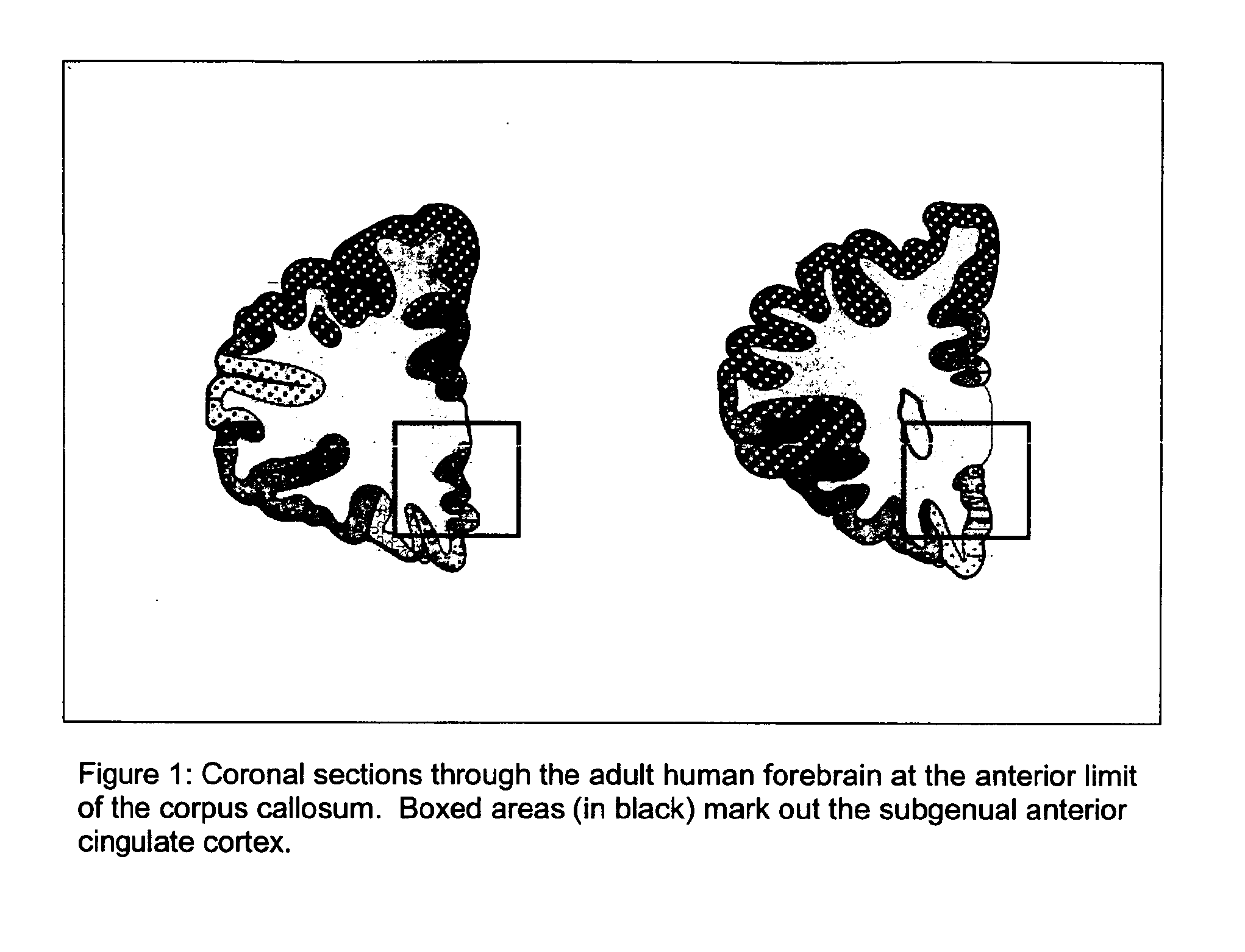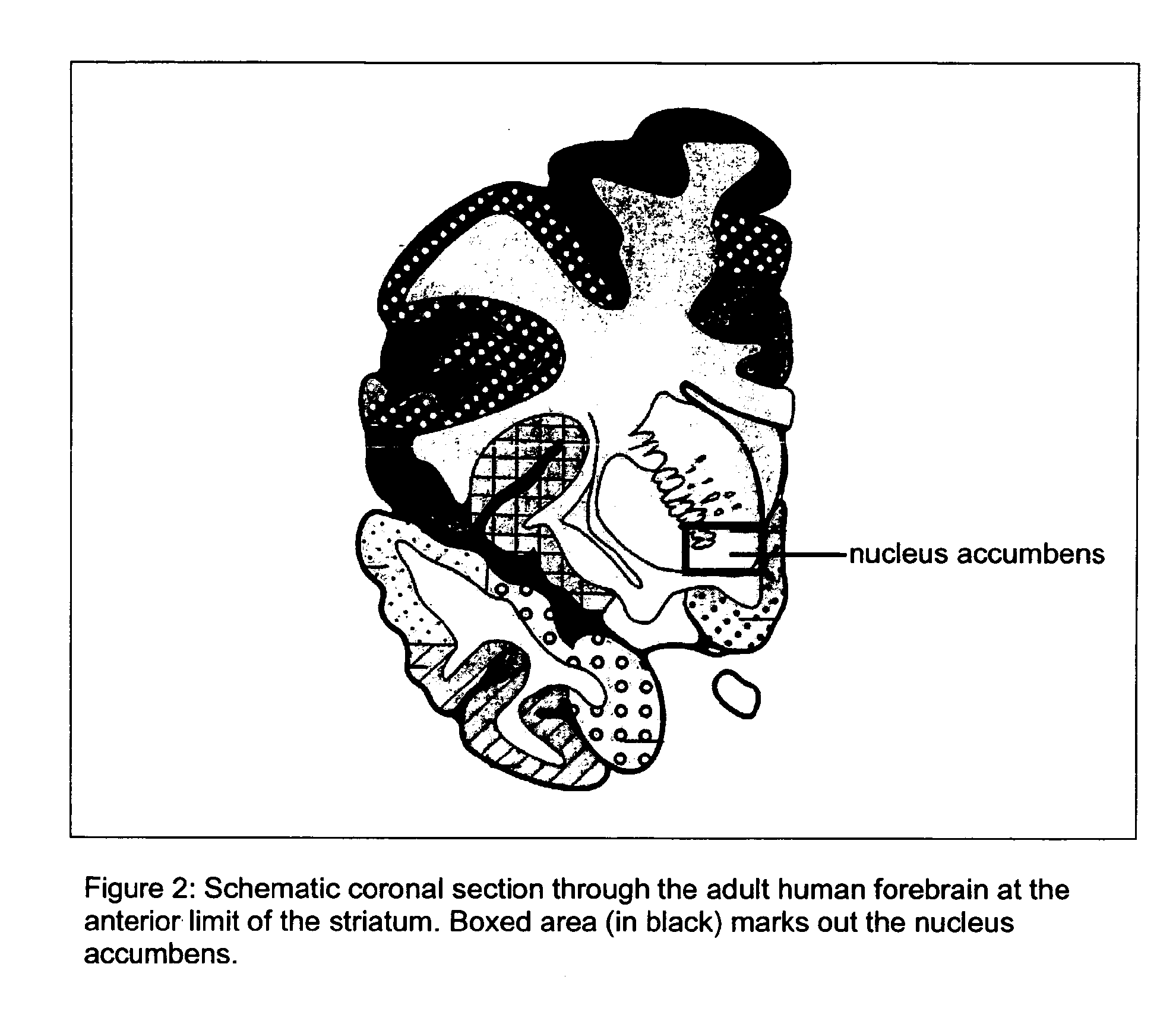Biomarkers for depression
a biomarker and depression technology, applied in the field of depression biomarkers, can solve the problems of unsatisfactory current anti-depression drugs, 15% risk of manic episodes, and no gene expression study specifically teaches an association with late-onset depression
- Summary
- Abstract
- Description
- Claims
- Application Information
AI Technical Summary
Benefits of technology
Problems solved by technology
Method used
Image
Examples
example 1
Anterior Cingulate Transcriptomics
Example 1(i) Sample Selection
[0120]Frozen brain tissue (stored at −80° C.) was obtained from the frontal cortex of 10 subjects with late-onset depression, and matched for age, sex, post mortem interval and agonal state with 10 psychiatrically healthy control subjects. All subjects died suddenly, with a mean duration of agonal state of about 7 hours (Li et al Hum Mol Genet. 13, 609-616 (2004)). These numbers were selected as being sufficient to detect group differences at conventional significance levels on the microarray of >±2SD, or using DIGE based proteomic analysis. Depressed subjects had all had DSM-IV major depression and case note review confirmed this and they had no other mental illness. Case notes for controls were screened to ensure they had not had any psychiatric disorder. All subjects received a postmortem and neuropathological examination and none had changes consistent with dementia.
[0121]The tissue was screened for its suitability f...
example 1 (
Example 1(ii) Microarray Analysis
[0122]Following evaluation, a restricted set of samples was available for analysis (see Table 1 below). From this sample set, subgenual anterior cingulate cortex (see FIG. 1) was selected and microdissected at −20° C. These samples were stored frozen at −80° C. and subsequently processed for RNA analysis. For preparation of RNA, samples were thawed and a 10% homogenate prepared by homogenising for 10 seconds at full speed with a UltraTurrax homogeniser. Sample pH was determined and RNA was extracted using guanidine based extraction (TriZOL) and post isolation purification on columns (RNEasy, Qiagen) to remove low molecular weight RNA. RNA quality was determined on the basis of clear 18 / 26S ribosomal bands using an Agilent Bioanalyzer.
TABLE 1Anterior Cingulate RNA Samples Extracted for MicroarrayAnalysisSample NumberRIN*MicroarrayAC16.5YesAC26.2YesAC36.7YesAC45.5NoAC54.6NoAC66.3YesAC74.1NoAC86.2YesAC94.8NoAC105.0YesAC116.5YesAC124.5NoAC137.9YesAC146.9...
example 2
Nucleus Accumbens Transcriptomics
Example 2(i) Sample Selection
[0126]Post mortem brain tissue from individuals with late onset depression and individuals without a known neuropsychiatric history has been screened for its suitability for use by assessing pH as a marker of agonal state. Samples from frontal cortex (BA 45) were obtained from storage at −80° C., subdissected, thawed and a 10% homogenate (1 gram tissue plus 9 ml water) prepared by homogenising for 10 seconds at full speed with a UltraTurrax homogeniser. Sample pH was determined using a silver chloride electrode calibrated with aqueous standards.
PUM
| Property | Measurement | Unit |
|---|---|---|
| Fraction | aaaaa | aaaaa |
| Atomic weight | aaaaa | aaaaa |
| Atomic weight | aaaaa | aaaaa |
Abstract
Description
Claims
Application Information
 Login to View More
Login to View More - R&D
- Intellectual Property
- Life Sciences
- Materials
- Tech Scout
- Unparalleled Data Quality
- Higher Quality Content
- 60% Fewer Hallucinations
Browse by: Latest US Patents, China's latest patents, Technical Efficacy Thesaurus, Application Domain, Technology Topic, Popular Technical Reports.
© 2025 PatSnap. All rights reserved.Legal|Privacy policy|Modern Slavery Act Transparency Statement|Sitemap|About US| Contact US: help@patsnap.com


